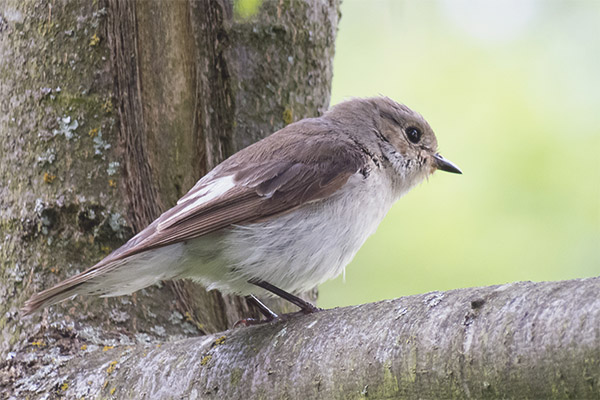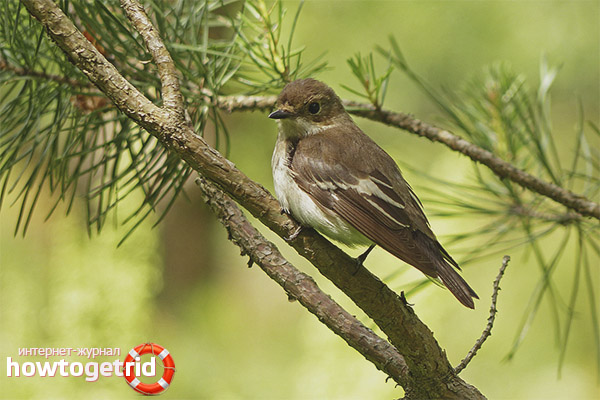The content of the article
The pied flycatcher bird belongs to the Flycatcher family. In the territory of the central Europe of representatives of this family lives a little. In appearance, this bird is inconspicuous, small. It is smaller in size than a sparrow. Despite this, the bird brings a lot of benefit to people, exterminating harmful insects. In Latin, the species name sounds like Ficedula hypoleuca.
Description
In the flycatcher, near the base of the beak, there are bristles that perform the function of touch. The eyes are dark, round in shape. At the tip of the beak is pointed, but the base is wide. Due to the fact that the bird has rather long wings, it is able to fly quickly. In the flycatcher in the upper body, on the wings and head, the color of the plumage is black. On the abdomen, partly on the wings, tail, and also on the forehead white plumage. The legs of this bird are thin, gray.
In the pied flycatcher, the tail feathers located on the tail are relatively short. Boats with 4 fingers. Three are directed forward, and one - back. They grow sharp claws.The body length of this bird is only about 12 cm. The wingspan is 22 cm.
Habitat
This species refers to typical migratory birds. Their nesting sites are common throughout Europe. They do not live only in the south of this part of the world. You can meet a bird in Western Siberia and in the north-western part of Africa. They live almost everywhere, where there are tall trees. You can see the flycatcher in coniferous, deciduous, mixed forests. Sometimes they settle in gardens and groves, and even in abandoned cities or cemeteries. The bird prefers to winter in a tropical forest.
Breeding
Males return from wintering grounds a few days earlier than females. One male usually occupies 2-3 plots where he finds various hollows or birdhouses. Loved the plot, the bird sings loudly to notify its neighbors that the territory is already occupied. Singing attracts females.They choose partners for themselves as soon as they return from hot Africa. One male may well attract the attention of several females at the same time. Each takes place found by the male.
When offspring appears, the male helps only one of the females to take care of it. Most often, this is the first of all who flew at the call. In turn, all other females respond to the call of other males as well. Therefore, it is very often the case that chicks from the same clutch have different fathers. As soon as the female builds the nest, she immediately lays her eggs. This happens in May. The number of eggs ranges from 4 to 7. They are bluish-green in color. Only female is engaged in incubation. This period lasts about 2 weeks. And the male during this period brings food for her. Parents feed chicks with caterpillars and various small insects.
Lifestyle
When a bird lives in nesting places, it does not fly away from its site, but hunts nearby. When the chicks grow up and stand on the wing, the flycatchers gather in flocks to fly away for the winter. There they are kept in packs, together they search for food and spend the night in the trees.
The basic diet of birds is flying insects. Sometimes can eat and spider.They hunt more often, trapping prey in ambush. She finds a convenient place where you can safely look out for prey. All neighborhoods should be viewed from this perch. As soon as from its shelter the pied flycatcher sees the prey, immediately takes off and flies after it. Insect she grabs on the fly with her strong and tenacious beak.
Since the bird wings are long and narrow, it can quickly fly and make various maneuvers. Sometimes it can hover in the air for a short time in order to peck prey right off the leaf, like hummingbirds do.
Sometimes her hunt is different. She sits on a branch in the crown of a tree, and looks out for the caterpillars, wagging her tail. When the flycatcher spotted the victim, she would definitely catch it. Sometimes she looks for insects on the ground.
Related species
The flycatcher family includes 275 bird species. All of them are small in size and inhabit the territory of Eurasia and Africa. Their food consists of various insects and spiders. Some species belonging to the family have a very bright color. This refers to species found in the subtropics and the tropics. And those that live in areas with a temperate climate, are migratory. They nest in the northern territories, and fly to warm countries for the winter. They live in forests of any type.In addition, they can be seen in the city, for example, in the garden or garden.
Interesting Facts
- Flycatchers bring man a lot of good. After all, they destroy a large number of harmful insects, including those that harm forests. Therefore, this species is protected in some countries.
- Some species belonging to this family live in the mountains. The orange-necked flycatcher lives at an altitude of up to 4 thousand meters in the Himalayas. She hunts in the thickets, flying into the upper borders of forests.
- Among all flycatchers, there are species that are facing extinction. This applies to those species that occupy a small area. Among them are jungle flycatcher. This view can be found only on about. Negros. Here the species is threatened with extinction, because on the island forests are cut down with great intensity. If the destruction of nature on this island does not stop, the view will disappear completely. After all, nowhere else in the world can you find such a bird.
- Many species of the family of flycatchers build their nests in the form of a bowl. They have them on a tree or in dense bush thickets. Sometimes the nest can be found in the cracked wall of an abandoned house.Among them are species that give two offspring in one season.
Video: Pied Flycatcher (Ficedula hypoleuca)












To send